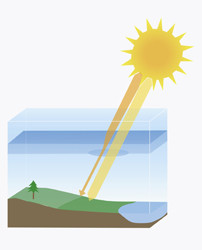Predicting ozone layer depletion
Halogens (e.g. chlorine, bromine and iodine) have contributed to the decline of the global ozone layer, which absorbs most of the Sun's ultraviolet radiation. The Montreal Protocol (1987) was responsible for phasing out the production of various ozone-depleting substances (ODSs) such as halogenated hydrocarbons. Naturally emitted medium short-lived substances (MSLSs) and very short-lived substances (VSLSs) containing bromine and iodine can enter the stratosphere. Here, in the second major layer of Earth's atmosphere, they are broken down by sunlight to release ozone destroying halogens. The 'Stratospheric ozone: Halogen impacts in a varying atmosphere' (SHIVA)(opens in new window) initiative aimed to increase understanding of the role of VSLSs. This will ensure that predictions of the future state of the global stratospheric ozone can be made with greater certainty for a changing climate. Determining the uncertain contribution of MSLSs and VSLSs to the production of ozone-depleting halogens is challenging due to their sensitivity to climate changes. Sources of VSLSs include marine plants known as phytoplankton, as well as non-living chemical and physical processes that occur near the surface of the oceans. VSLS emissions from natural or cultivated seaweed are also potentially important, particularly in tropical regions of the world. Tropical weather is warm and helps to carry ODSs into the stratosphere, thus contributing to ozone loss. The consortium therefore conducted long-term measurements in conjunction with Malaysian research partners in the South China Sea and along the coastline of the Malaysian Peninsula and Borneo. Air measurements were taken from land, ships, aircraft, balloons and satellites and combined with computer models. Data from the SHIVA initiative will reduce uncertainty in predicting climate changes and ozone recovery or losses. In addition, the project will increase understanding of the future oxidation capacity of the lower atmosphere, as well as the composition and dynamics of the overlaying stratosphere. The work conducted by the SHIVA consortium contributed to the scientific basis of the United Nations (UN) Montreal Protocol on Substances that Deplete the Ozone Layer, the UN Convention on Climate Change and global climate change research.







